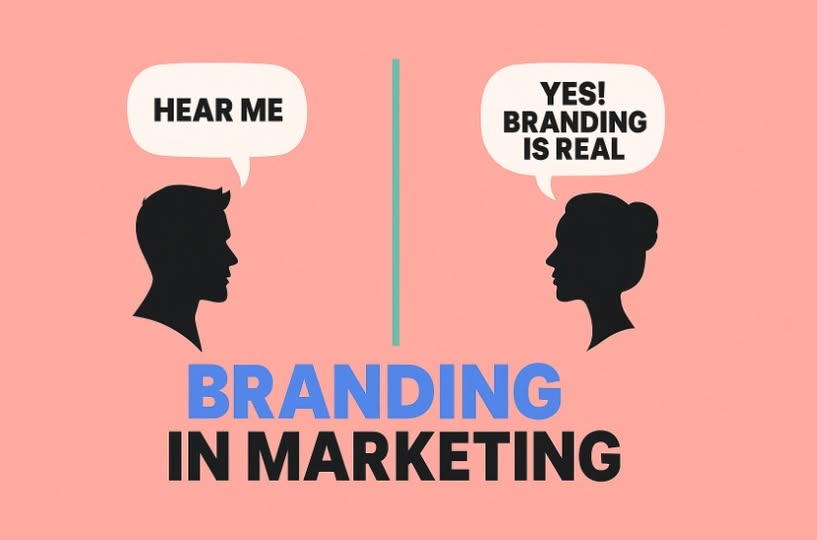Let’s cut right to it. Most people think branding is a logo and marketing is running ads.
They see them as two separate things.
That’s a huge mistake. And it’s costing them big time.
Branding isn’t a side dish to your marketing main course. Branding is the plate everything is served on. It’s the invisible force that makes all your marketing efforts, your ads, your contents, your social media marketing, either work brilliantly or fall completely flat.
So, what is branding in marketing?

It’s the art and science of making your business unforgettable. It’s how you get people to choose you without a second thought, even when you’re not the cheapest option. It’s the difference between being “a company that sells running shoes” and being Nike.
If you’re just running ads without a strong brand, you’re in a race to the bottom, constantly fighting on price. But when you master branding in your marketing, you create something priceless: a deep connection with your audience.
Let’s break down how to do it.
First, Let’s Be Clear: Branding IS Your Marketing Foundation
Think of it like this:
- Marketing is the activity of getting attention. It’s the megaphone. It’s your Facebook ads, your SEO strategy, your email campaigns. It’s how you shout, “Hey! Look at me!”
- Branding is what people remember after you’ve stopped shouting. It’s the story, the feeling, and the promise that sticks in their mind. It’s why they should care.
Without strong branding, your marketing is just noise. You might get a click, but you won’t get a customer for life. Effective branding gives your marketing direction, consistency, and a personality that people can connect with. Every ad you run, every post you share, should be a puzzle piece that fits into the larger picture of your brand.
Why Branding is Your Marketing Superpower
Still not convinced? Let’s look at why integrating branding into your marketing isn’t just a good idea, but it’s the only way to win in the long run.
Branding is your marketing superpower because it gives your business a unique identity that connects deeply with your audience. A strong brand goes beyond visuals and it builds trust, customers loyalty, and emotional connection. When people recognize your logo, tone, and message instantly, they remember your value over competitors. Branding transforms marketing from simple promotion to storytelling, making every campaign more effective.
It turns customers into advocates and ensures your business stands out in a crowded market, driving long-term growth and credibility with every interaction.
1. It Makes You Memorable in a Sea of Sameness
There are thousands of businesses shouting for your customer’s attention. A memorable brand cuts through the clutter.
Think of Mailchimp. In a world of boring, technical email software, they showed up with a playful monkey mascot (Freddie), a friendly voice, and bright yellow branding. Their branding made them instantly recognizable and approachable. When it came time to choose an email provider, who do you think people remembered? The generic “Email Solutions Inc.” or the fun brand with the chimp?
Your branding is your unique fingerprint in the market.
2. It Builds Trust (And Trust Sells)
People do business with companies they know, like, and trust. Consistent branding is a shortcut to building that trust.
When your marketing messages, visuals, and tone are all aligned, you appear professional and reliable. Every time a potential customer sees your consistent branding across different platforms—your website, your social media, an ad—it reinforces their perception of you. This familiarity breeds trust long before they ever click “buy.”
3. You Can Stop Competing on Price
Why do people pay $1,000 for an iPhone when a $300 Android phone does many of the same things? The answer is brand equity.
Apple has invested decades in branding itself as innovative, premium, and user-friendly. Their marketing doesn’t just sell features; it sells a lifestyle. This powerful brand perception allows them to command a premium price.
When your brand means something to people, the conversation shifts from “How much does it cost?” to “How can I get it?”
4. It Fuels Brand Awareness and Word-of-Mouth
Great branding gives people something to talk about. It turns customers into fans, and fans into volunteer marketers.
Look at Dollar Shave Club. Their launch video went viral not because of the razors, but because of the brand’s hilarious, irreverent personality. People shared it because it was entertaining. That single piece of brand-driven marketing created massive brand awareness and built a billion-dollar company. When your brand is cool, funny, or inspiring, people want to be associated with it and share it with their friends.
How to Weave Branding into Your Marketing Strategy
Ready to put this into action? Here’s how you can infuse strong branding into every aspect of your marketing.
Step 1: Define Your Brand Core
Before you can market your brand, you have to know what it is. This is the foundational work that most people skip. Don’t be most people.
- Your Mission: What is your purpose? What problem do you solve? Example: “To organize the world’s information and make it universally accessible and useful.” (Google). This guides the value your marketing should communicate.
- Your Vision: What is the future you want to create? Example: “A world without Alzheimer’s disease.”. This provides the emotional, aspirational core for your marketing stories.
- Your Brand Values: What are the 3-5 core principles you live by? Honesty? Innovation? Sustainability? These values should be reflected in your marketing campaigns. Patagonia’s marketing is all about environmentalism because it’s a core brand value.
Step 2: Know Your Audience Inside and Out
You can’t build a brand for everyone. You need to identify your tribe—the specific group of people who will love what you do. Create a detailed buyer persona.
Ask yourself:
- What are their biggest pain points and challenges?
- What are their aspirations and dreams?
- What kind of humor do they have? What’s their communication style?
- Where do they spend their time online? (This tells you where to market).
Your brand’s personality should be a reflection of the person your ideal customer wants to hang out with.
Step 3: Develop a Consistent Brand Voice and Visuals
Consistency is the key to recognition and trust.
- Brand Voice: Is your brand witty and sarcastic like Wendy’s on Twitter? Or is it inspiring and empowering like Nike? Define your tone and use it everywhere—from your ad copy to your customer support emails.
- Visual Identity: This is your logo, color palette, and typography. Create a simple brand style guide and stick to it religiously. When someone sees your ad on Instagram, it should look and feel the same as your website’s homepage. This visual consistency makes you instantly recognizable.
Step 4: Execute with Brand-Led Marketing Campaigns
Now, let’s apply this to your actual marketing activities.
Content Marketing
Your content is the perfect place to let your brand’s personality shine.
Content marketing is more than just publishing blog posts, it’s about building trust and delivering real value to your audience. When you educate, inspire, or solve a problem, people naturally connect with your brand. Focus on consistency, storytelling, and strategy to turn readers into loyal customers that’s how great content drives growth.
- What to do: Create blog posts, videos, or podcasts that are genuinely helpful and reflect your brand’s expertise and voice. Don’t just sell—educate, entertain, and inspire. Red Bull doesn’t just post about its energy drink; it creates high-octane content about extreme sports because its brand is about adrenaline and pushing limits.
Social Media Marketing
Let’s be honest, social media isn’t about shouting louder; it’s about connecting smarter. Every post is an opportunity to build trust, start a conversation, and show what your brand stands for.
Stay consistent, add value, and watch engagement turn into loyalty. Remember each social platform is a stage for your brand’s personality.
- What to do: Don’t just post product pictures. Share behind-the-scenes content. Engage with your followers in your brand voice. Run polls that reflect your brand’s sense of humor. Use your brand colors and fonts in your graphics. Make your feed a destination, not just a catalog.
Paid Advertising
Your ads should be an extension of your brand story.
- What to do: Use imagery, copy, and calls-to-action that align with your brand. An ad for a luxury brand should look and feel different from an ad for a discount retailer. Test messages that appeal to the emotional drivers of your target audience, not just the logical features of your product.
Email Marketing
The inbox is an intimate space. It’s the perfect channel for building a deeper brand relationship.
Email marketing isn’t dead, it’s smarter than ever. When done right, every email feels personal, valuable, and timely. It’s not about blasting messages; it’s about nurturing relationships. Use segmentation, storytelling, and clear CTAs to build trust and drive conversions by doing email marketing.
The goal? Make your audience actually look forward to hearing from you.
- What to do: Craft subject lines in your brand voice. Design email templates that use your brand’s visual identity. Tell stories in your newsletters. Make your subscribers feel like insiders and part of a community.
Final Thoughts: Stop Marketing, Start Branding
The biggest mistake businesses make is treating marketing as a series of disconnected tactics aimed at short-term sales. This approach is a constant, uphill battle.
The most successful companies play a different game. They focus on building a brand in businesses. They understand that every marketing action is a chance to tell their story, strengthen their reputation, and build a lasting connection with their audience.
When you lead with branding, your marketing becomes easier and more effective. You attract customers who are loyal, who spend more, and who become your biggest fans. You build a moat around your business that no competitor can easily cross.
So take a step back from your ad campaigns and SEO reports. Ask yourself: What does my brand stand for? What story are we telling? And is that story present in everything we do?
Answer those questions, and you’ll unlock the true power of branding in marketing.

